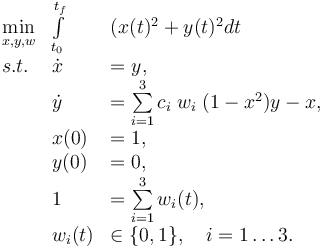Difference between revisions of "Van der Pol Oscillator (binary variant)"
From mintOC
ClemensZeile (Talk | contribs) |
ClemensZeile (Talk | contribs) |
||
| Line 35: | Line 35: | ||
<gallery caption="Reference solution plots" widths="180px" heights="140px" perrow="2"> | <gallery caption="Reference solution plots" widths="180px" heights="140px" perrow="2"> | ||
| − | Image: | + | Image:VanderpolRelaxed 6000 100 1.pdf| Optimal relaxed controls and states determined by an direct approach with ampl_mintoc (Radau collocation) and <math>n_t=6000, \, n_u=60</math>. |
| − | Image: | + | Image:VanderpolCIA_6000_100_1.pdf| Optimal binary controls and states determined by an direct approach (Radau collocation) with ampl_mintoc and <math>n_t=6000, \, n_u=60</math>. The relaxed controls were approximated by Combinatorial Integral Approximation. |
</gallery> | </gallery> | ||
| + | == Source Code == | ||
| + | Model description is available in | ||
| + | * [[:Category:AMPL | AMPL code]] at [[Van der Pol Oscillator binary variant(AMPL)]] | ||
Latest revision as of 19:05, 10 January 2018
| Van der Pol Oscillator (binary variant) | |
|---|---|
| State dimension: | 1 |
| Differential states: | 2 |
| Discrete control functions: | 3 |
| Interior point equalities: | 2 |
This site describes a Van der Pol Oscillator variant with three binary controls instead of only one continuous control.
Mathematical formulation
The mixed-integer optimal control problem is given by

Parameters
These fixed values are used within the model:
![[t_0,t_f]=[0,20], c_1=-1, c_2=0.75, c_3=-2.](https://mintoc.de/images/math/6/5/5/6556b72c5eff2a3dcb8b0c40da03d1fd.png)
Reference Solutions
If the problem is relaxed, i.e., we demand that  be in the continuous interval
be in the continuous interval ![[0, 1]](https://mintoc.de/images/math/c/c/f/ccfcd347d0bf65dc77afe01a3306a96b.png) instead of the binary choice
instead of the binary choice  , the optimal solution can be determined by means of direct optimal control.
, the optimal solution can be determined by means of direct optimal control.
The optimal objective value of the relaxed problem with  is
is  . The objective value of the binary controls obtained by Combinatorial Integral Approimation (CIA) is
. The objective value of the binary controls obtained by Combinatorial Integral Approimation (CIA) is  .
.
- Reference solution plots
Source Code
Model description is available in